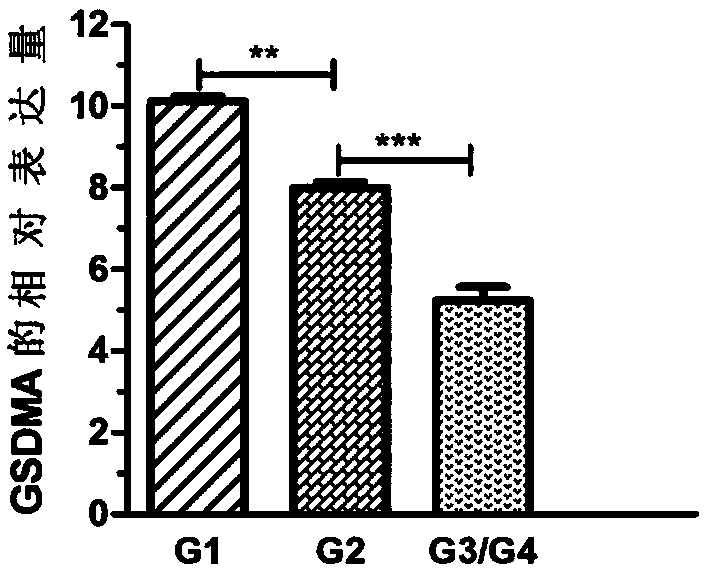Application of biomarker to assessment of oral squamous cell carcinoma hazard levels
A technology of risk level and oral squamous cell carcinoma, which is applied in the field of GSDMA, can solve the problems that the influence of subjective factors cannot be ruled out and the lack of quantitative standards, etc., and achieve the effects of avoiding insufficient treatment intensity, improving treatment effect, and high specificity
- Summary
- Abstract
- Description
- Claims
- Application Information
AI Technical Summary
Problems solved by technology
Method used
Image
Examples
Embodiment 1
[0076] Example 1 Screening Gene Markers Related to Oral Squamous Cell Carcinoma
[0077] 1. Sample collection
[0078] 68 oral squamous cell carcinoma tissues and adjacent tissues were collected, including 20 patients with histological grade I (G1), 30 patients with histological grade II (G2), and histological grade III / There were 18 patients with grade IV (G3 / G4). The patient did not receive any treatment before operation. All the above-mentioned samples were obtained with the consent of the organizational ethics committee, and 4 samples were taken from each group for detection and analysis of gene expression profiles, screening of differentially expressed genes, and verification experiments were carried out in all samples of each group.
[0079] 2. Preparation of RNA samples (operated using QIAGEN tissue RNA extraction kit)
[0080] Take out the tissue samples frozen in liquid nitrogen, put the tissue samples into a pre-cooled mortar for grinding, and extract and isolate...
Embodiment 2
[0095] Example 2 QPCR sequencing to verify the differential expression of GSDMA genes
[0096] 1. Large-sample QPCR verification of differential expression of GSDMA genes.
[0097] 2. The RNA extraction steps are as described in Example 1.
[0098] 3. Reverse transcription:
[0099] Use the FastQμant cDNA First Strand Synthesis Kit (Product No.: KR106) for mRNA reverse transcription, first remove the genomic DNA reaction, add 5×gDNA Bμffer 2.0μl, total RNA 1μg, add RNase Free ddH 2O Make the total volume to 10μl, heat in a water bath at 42°C for 3min, then add 2.0μl of 10×Fast RT Bμffer, 1.0μl of RT Enzyme Mix, 2.0μl of FQ-RT Primer Mix, RNase Free ddH 2 O5.0 μl, after mixing, add to the above-mentioned test tube and mix together a total of 20 μl, heat at 42°C for 15 minutes in a water bath, and heat at 95°C for 3 minutes.
[0100] 4. QPCR amplification detection
[0101] QPCR amplification primers were designed according to the sequences of GSDMA and GAPDH, and synthesize...
PUM
 Login to View More
Login to View More Abstract
Description
Claims
Application Information
 Login to View More
Login to View More - R&D
- Intellectual Property
- Life Sciences
- Materials
- Tech Scout
- Unparalleled Data Quality
- Higher Quality Content
- 60% Fewer Hallucinations
Browse by: Latest US Patents, China's latest patents, Technical Efficacy Thesaurus, Application Domain, Technology Topic, Popular Technical Reports.
© 2025 PatSnap. All rights reserved.Legal|Privacy policy|Modern Slavery Act Transparency Statement|Sitemap|About US| Contact US: help@patsnap.com

